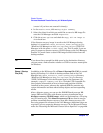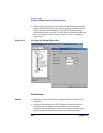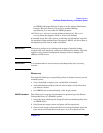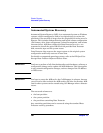
Disaster Recovery
One Button Disaster Recovery of a Windows System
Chapter 10 473
Requirements
• Data Protector Automatic Disaster Recovery and User Interface
components must be installed on the systems for which you want to
enable recovery using this method. See HP OpenView Storage Data
Protector Installation and Licensing Guide.
• It is essential to have an OBDR capable computer configuration: the
system’s BIOS must support bootable CD extensions as defined in the
El-Torito standard and read/write access to hard disk drive using
LBA addressing via INT13h function XXh. The OBDR device must
conform to the same standard when emulating the CD-ROM. The
BIOS options can either be checked in the user’s manuals of the
system or by inspecting the system setup before the boot.
For more information about supported systems, devices and media,
please refer to the HP StorageWorks Tape Hardware Compatibility
Table on the World Wide Web:
http://www.openview.hp.com/products/datapro/spec_0001.html
. Also
see the HP OpenView Storage Data Protector Software Release Notes.
• The hardware configuration of the target system must be the same as
of the original system. This includes SCSI BIOS settings (sector
remapping).
• Replacement disks have to be attached to the same host bus adapter
on the same bus.
• An additional 200 MB of free disk space is required on the boot
partition at backup time. If this disk space is not available, the
disaster recovery fails. If you had applied the Compress Drive on the
original partition, you must have 400 MB free.
• All drivers, required for boot must be installed under the
<%SystemRoot%> folder.
• Network must be available when you boot the system in Safe Mode
with Networking or in Directory Services Restore Mode (Domain
Controller only), but you must do the backup of the system after it
was booted with normal boot process.
• A media pool with a Non-appendable media usage policy and Loose
media allocation policy has to be created for the OBDR capable
device. Only the media from such pool can be used for disaster
recovery.


















